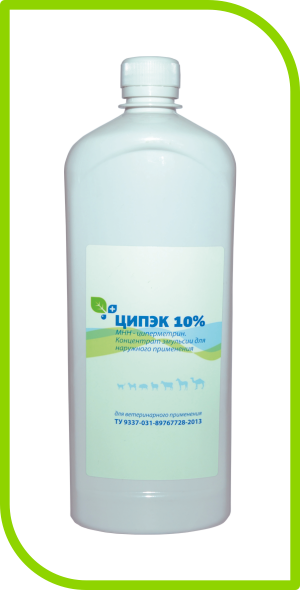INSTRUCTION
of using Cipec 10%, 25%, 50% for the control of lice, flies, gnats, ixodids and scabies, chicken puffers and other ectoparasites of animals.
(Organization-developer: “BioKhimPharm”, Vladimir region Raduzhny)
I. General information
1. Trade name of the medicinal product: CIPEC 10%, 25%, 50%.
International non-proprietary name: cypermethrin.
2. Drug form of the preparation: emulsion concentrate for external use.
The preparation contains in 1 ml as an active substance 100 mg or 500 mg cypermethrin, as well as auxiliary substances.
CYPEC 10%, 25%, 50% are produced in cans of polymeric material with screw plugs. Shelf life of the drug under the storage conditions is 2 years from the date of manufacture.
It is forbidden to use Cipec 10%, 25%, 50% after the expiry date.
Each package is marked in accordance with the requirements of regulatory and technical documentation.
4. The preparation is stored in the manufacturer’s closed packaging in the dark place at a temperature of minus 10 ° C. up to 25 ° C away from heating devices.
5. CIPEC 10%, 25%, 50% should be stored in places inaccessible to children.
6. An unused product with expired shelf life, and also empty containers should be burned or buried away from water sources.
II. Pharmacological properties
7. Pharmacotherapeutic group of medicinal product: antiparasitic agent.
The drug is effective against most important ectoparasites of farm animals:
– iksodovyh ticks parasitizing on one or several kinds of animals, -checke mites of cattle, sheep and camels, mites and puffers of chickens, lice in pigs, sheep and cattle, -blogs of fur-bearing animals and dogs, -carus-sucking and others flies, protects animals from the larvae of parasitic flies.
CIPEC 10%, 25%, 50% effective against ectoparasites resistant to organochlorine, organophosphorus compounds, carbamates and amidines.
Pharmacological properties of CIPEC 10%, 25%, 50% are due to the active ingredient in its composition cypermethrin.
Cypermethrin is an insecticidal-acaricidal agent of intestinal contact from the class of synthetic pyrethroids. It is active against various species of ticks, flies, lice and other ectoparasites of animals. It breaks the function of the nervous system, acting on sodium-potassium channels and calcium exchange in the synapses, which leads to the release of excessive amounts of acetylcholine during the passage of the nerve impulse. Poisoning in arthropods is manifested in a strong excitation, lesion of motor centers, accompanied by paralysis and subsequent death. Has a long residual effect on the skin-hair cover of animals and the treated surfaces of the premises.
The drug is medium-toxic for warm-blooded animals (hazard class III according to GOST 12.1.007-76). In recommended doses, it does not have a local irritant and sensitizing effect. Toxic to fish and bees.
III. The order of application
8. CIPEC 10%, 25%, 50% Used to fight against lice, flies, gnatosis, ixodids and scabies, chicken puffers and other ectoparasites of animals by bathing and spraying animals with an aqueous emulsion or by watering with the use of the drug in a native form. Also, the drug is used to treat premises, cowhounds, pens in the presence of animals.
9. There are no contraindications to use.
10. Processing of animals. CYPEC 10%, 25%, 50% is used for bathing animals, spraying or brushing in accordance with the attached table, as well as the method of watering with the drug in its native (undiluted) form. CIPEC 10%, 25%, 50% is extremely stable when used in a dome bath. The drug is specially designed in such a way that does not occur stratification.
For the treatment of animals, a working emulsion of the preparation obtained by mixing the emulsion concentrate with water in the ratios given in the table is used.
|
Subject of treatment |
Parasites |
Method of application |
Dilution of the preparation |
||
|
CIPEC 10% |
CIPEC 25% |
CIPEC 50% |
|||
| Cattle, pigs |
All species |
Spraying (throughout the body) |
1 ml per 1000 ml of water |
2 ml per 5000 ml of water |
1 ml per 5000 ml of water |
| Cattle |
Flies |
Spraying along the back |
5 ml per 1000 ml
water, 500 ml of solution per anima |
2 ml per 1000 ml of water,
500 ml solution per animal |
1 ml per 1000 ml of water,
500 ml solution per animal |
| Cattle, sheep, goats |
All species |
Bathing |
“Bath filling: 1 liter per 1000 liters of water.
Topping up the volume of the bath: 1 liter per 1000 liters of water |
Filling the bath: 400 ml per 1000 liters of water
Topping up the volume of the bath: 400 ml per 1000 liters of water |
Filling the bath: 200 ml per 1000 liters of water
Topping up the volume of the bath: 200 ml per 1000 liters of water |
| Bird |
Pliers |
Spraying |
1 liter per 1000 liters of water |
400 ml per 1000 liters of water |
200 ml per 1000 liters of water |
| Fur animals |
All species |
Spraying of wool cover, sheds, houses |
1 liter per 1000 liters of water |
400 ml per 1000 liters of water |
200 ml per 1000 liters of water |
| Livestock facilities |
All species |
Spraying |
100 ml per 5-10 l of
water per 100 m2 of surface |
40 ml per 5-10 l of
water per 100 m2 of surface |
20 ml per 5-10 l of
water per 100 m2 of surface |
It is not recommended to make bathing in rainy weather. If there is heavy rain within 24 hours after treatment, all animals should be re-treated.
Before mass processing of animals, the drug is tested on a small group of animals (1-15 heads) of different ages and fatness. If within two days after application of the drug in the therapeutic concentration there are no signs of toxicosis using the same method, the entire population is treated.
To prepare a cupful emulsion, the sample of the preparation is thoroughly mixed with 2-3 volumes of water, and then poured into a bath with constant stirring. After treatment of the animal, the acaricidal liquid is poured into sludge wells, preventing contamination of the environment.
Spraying of animals is carried out from disinfection plants (LSD, DUK, VDM), with a rate of consumption of 1 liter per animal.
Repeated treatments of animals are carried out according to the indications, adhering to the following intervals:
– with melophagosis – 25-30 days;
– with sifunkulatose – 10 days:
– against ixodid ticks – throughout the pasture period with an interval of 9 days.
In the cold season, the animals are treated with a concentrate of the emulsion of CIPEK 10%, 25%, 50% in the native form by the method of watering. At the application site, the wool cover is pushed in different directions and the preparation is applied with a thin trickle in a dose of 5 ml of 10%, or 1 ml of 50% emulsion concentrate for every 10 kg of animal weight.
Processing of premises. CIIPEK 10%, 25%, 50% used for processing premises, sheep, pens in the presence of animals, including young animals. It is used against all flying and crawling arthropods, including cockroaches, red tick of birds (Dermanyssus), puhoedov, flour crustaceans, ants, bedbugs and others. Disinfestation and dezakarizatsiya premises is made by the method of small-drop spraying. The consumption of the drug depends both on the type of surface treated (concrete, stone, wood, plastic).
11. Symptoms of overdose when using the drug in accordance with this instruction is not established.
12. Features of the drug at the beginning of the application of CIPEC 10%, 25%, 50% or when it is canceled is not revealed.
13. Passage of the next dose of the drug (treatment) should be avoided, as this may lead to a decrease in therapeutic effectiveness. If one or more treatments are skipped, the drug is resumed as soon as possible in the same dosage and according to the same schedule.
14. Adverse events and complications in the application of CIPEC 10%, 25%, 50% in accordance with this instruction is not established.
15. The use of CIFEC 10%, 25%, 50% does not exclude the use of other drugs.
16. Processing of lactating animals is allowed. Milk can be used as food for people 6 hours after treatment.
Slaughter animals for meat is allowed no earlier than 3 days after bathing, spraying or watering the drug. In the case of forced slaughter of animals before the specified time, the meat can be used for feeding carnivorous animals or in the production of meat and bone meal.
IV. Precautionary measures
17. When working with CIPEC, 10%, 25%, 50%, you should follow the general rules of personal hygiene and safety, provided for when working with medicines.
18. When working with the drug, it is forbidden to drink, smoke and eat. After working with the drug, wash your hands with soap and water.
Work with the drug should be carried out in sets of overalls and personal protective equipment, including a robe, headdress, apron rubberized, rubber boots, anti-dust protective goggles, respirators of F-62 Sh (SHM), U-2K Astra-2, Petal-40 “and” petal-5 “or similar type.
Do not use empty containers from the medicine.
19. In case of contact with concentrate or aerosol, immediately:
– Wash skin thoroughly (with soap and plenty of water),
– several times wash eyes with a lot of water or 2% with a solution of baking soda,
– If the drug gets inside, drink a few glasses of water or a solution of potassium permanganate (1: 10000), induce vomiting, then drink 0.5 cups of 2% solution of baking soda.
– Remove contaminated clothing.
If a malaise is noted, you should immediately stop working and seek medical help.






